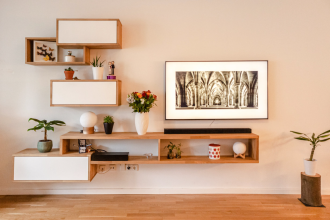Keeping your home tidy and organized is more than just a seasonal project, it’s a lifestyle shift that brings long-term peace of mind. From the moment you walk through the door, your environment should welcome you with calm and function, not chaos and confusion. The right storage solutions can make all the difference in maintaining a clean and clutter-free home, no matter the time of year.
Rather than waiting for a major spring-cleaning session or relying on frantic weekend organization, building smarter storage systems into your everyday life can help streamline routines and minimize stress. Whether you’re working with a compact apartment or a sprawling house, these six storage ideas are practical, flexible, and easy to maintain throughout the seasons.
Use External Storage to Free Up Prime Space at Home
When your closets and cabinets are filled with items you rarely use, like seasonal gear, family heirlooms, or bulky holiday decorations, it’s time to consider expanding your storage footprint. Sometimes, the solution lies not within the house but outside of it. Utilizing Welshpool storage options is one of the most efficient ways to reclaim your home’s interior without permanently parting with important items. These units offer secure and accessible spaces for overflow belongings, helping you rotate items in and out based on your current needs.
Instead of letting seldom-used items crowd your daily living areas, off-site storage keeps them protected and available when the time is right. This is helpful for families with children who outgrow toys and clothes quickly or for homeowners undergoing renovations who need a temporary solution to house furniture and decor.
Incorporate Dual-Purpose Furniture
Furniture that doubles as storage is a small-space dweller’s best friend, but even in larger homes, it’s a savvy solution that makes everyday organization easier. Look for ottomans that lift to reveal interior compartments, bed frames with drawers underneath, or coffee tables that offer shelving or concealed compartments.
These pieces provide immediate access to essentials while concealing them from view. Blankets, remote controls, children’s toys, and even paperwork can be neatly stowed without adding bulk to your rooms. The best part is that this type of storage doesn’t take up any additional floor space, which is ideal for maintaining open, breathable environments.
Establish Entryway Drop Zones
One of the most common areas to accumulate clutter is the home’s entryway. Shoes, bags, mail, keys, and jackets tend to pile up when there’s no clear place to put them. Creating a designated drop zone near your front or back door can reduce daily mess and build better habits for everyone in the household.
Wall hooks, shoe racks, a small bench with cubbies, or even labeled baskets can make a world of difference. Encourage family members to use the drop zone consistently by tailoring it to your household’s specific needs, make it functional, and visually pleasing to encourage regular use.
Rotate Seasonal Items
Many homes become overwhelmed simply because they try to accommodate too much at once. Winter coats, summer sandals, school supplies, and holiday decorations often co-exist, leading to overstuffed closets and drawers. One easy strategy is to rotate items based on the season.
Store off-season clothing, gear, and décor in labeled bins or vacuum-sealed bags. When the weather changes or the holidays approach, simply swap your stored items and keep your daily-use areas functional and lean. Garages, attics, and closets with vertical space are great for rotating systems, but if space is limited, this is another scenario where external storage can lend a hand.
Maintaining this system helps you re-evaluate belongings throughout the year. As you rotate, it’s a good time to donate or discard anything no longer needed, preventing unnecessary accumulation.
Use Vertical Space Wisely
Many homeowners underutilize their vertical space. Walls, the backs of doors, and even ceilings can be transformed into storage solutions that don’t encroach on your floors or living space.
In the kitchen, install vertical shelves or pegboards for utensils, pots, and spices. In the bathroom, floating shelves or over-the-toilet units can hold toiletries and towels. Bedrooms can benefit from high shelving or wall-mounted cabinets in children’s rooms, where toys and books can quickly take over.
Make Decluttering a Monthly Habit
Even the best storage systems need maintenance. By dedicating just a small window of time each month to a quick sweep of your spaces, you can avoid overwhelming clean-outs down the line. Choose one area each month, a bathroom cabinet, your home office, or a specific closet, and evaluate what can be tossed, relocated, or repurposed.
Involving the whole family in these mini-declutter sessions makes the workload lighter and helps build long-lasting habits. Children benefit from learning how to sort their toys and clothes, which instills a sense of ownership and responsibility.
Keeping your home clutter-free year-round isn’t about perfection; it’s about systems that support your lifestyle and reduce stress. By integrating smart furniture, utilizing external solutions, and consistently reassessing what you truly need, you build a home that serves you, not the other way around.












